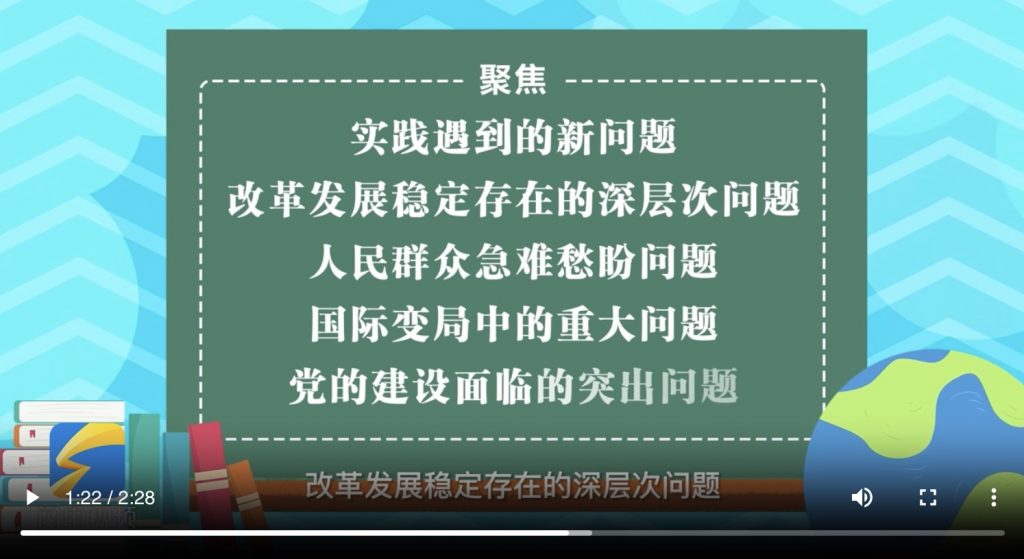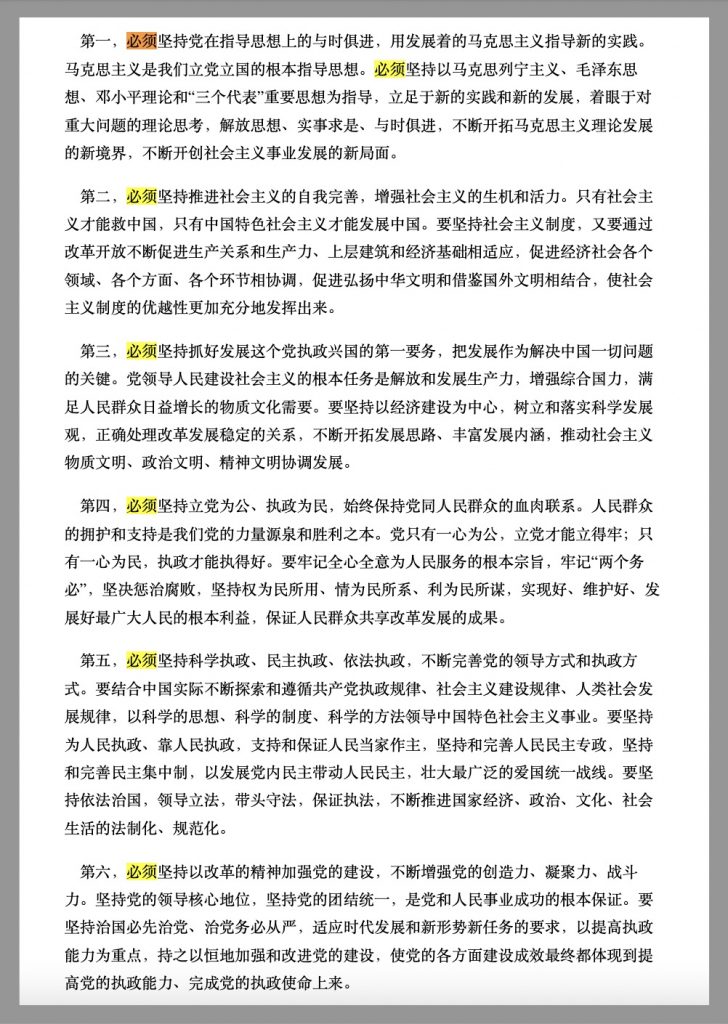Since the 20th National Congress of the CCP in October 2022, the phrase “Six Adheres,” or liuge bixu jianchi (六个必须坚持), has been promoted by China’s Party-state media as a comprehensive model to convey the methods and worldview of the Chinese Communist Party. Each of the six concepts has been elaborated at length in the Party’s official People’s Daily newspaper and other media. They prescribe that China and the CCP must adhere to:
- The supremacy of the people (人民至上): All theories that depart from the people are “pale and feeble” (苍白无力), and those that do not bring prosperity to the people “have no vitality” (没有生命力).
- Self-confidence and self-sufficiency (自信自立): China must adhere to a “firm faith” (坚定信仰) in the tenets of socialism, and a “firm belief” (坚定信念) in Xi Jinping Thought. This involves the so-called “Four Confidences” (四个自信), which for a time in 2021 became five.
- Integrity and Innovation (守正创新): Here the leadership emphasizes “science” and having a “scientific attitude” (科学的态度) toward problems, as well as emphasizing the pursuit of “truth” (真理). The CCP’s understanding of both “science” and “truth” can depart radically from normative understandings outside of China. On “science,” for example, readers might check out the CMP partner project Decoding China.
- A problem-solving orientation (问题导向): The CCP lists out a series of problems or issues to be considered in the process of governance, policy-making, and international relations, asserting the need to “raise new concepts, new thoughts, and new methods that can truly resolve issues.”
- A system concept (系统观念): This encompasses the notion that the CCP must think and act more holistically (or according to the Party’s own idea of what that entails), adhering to seven types of “thinking” in its work, including: “strategic thinking” (战略思维); “historical thinking” (历史思维); “dialectical thinking” (辩证思维); “systematic thinking” (系统思维); “innovative thinking” (创新思维); “rule of law thinking” (法治思维); and “bottom-line thinking” (底线思维).
- Cherishing the world (胸怀天下): This is where what otherwise seems a quite insular and at times incomprehensible set of concepts seeks to open out to the world. The concept says that China and the CCP must expand their “global view” (世界眼光), and must “answer the concerns of the people of various nations” (各国人民普遍关切). The idea is that China’s core interests are interconnected with those of the world and that China can contribute to solving the most pressing issues facing the world. China’s more active foreign policy in recent years, intensifying in recent months, can be seen as part of this concept.
Each of these specialized phrases is seen to be a key aspect of the spirit of China’s current ruling concept, encompassed by Xi Jinping’s lengthy banner phrase (旗帜语), “Xi Jinping Thought on Socialism with Chinese Characteristics for a New Era” (习近平新时代中国特色社会主义思想) [More in the CMP Dictionary]. In turn, as should be evident from the brief summaries in the list above, each phrase subsumes a constellation of other terms from CCP discourse.

The “Six Adheres” phrase is an excellent example of how the Party continually constructs elaborate frameworks for conceptualizing its work, asserting power and prestige (Xi’s banner term), consolidating CCP leadership, interpreting CCP history, and conducting propaganda for all of the above.
Further, the phrase demonstrates how specialized vocabularies can be deconstructed and reinterpreted over time by the CCP, as the leadership and its priorities change.
In fact, there have been four distinct iterations of the “Six Adheres” in the official CCP discourse, all during the reform period — including three since Xi Jinping came to power. While each of these has been called the “Six Adheres,” their content is distinct in ways that can be revealing.
Adhering the Jiang and Hu Eras
The first “Six Adheres,” introduced in October 2004, in the early Hu Jintao era, dealt with the nature of power and governance in China. The phrase was included in the decision on strengthening governing capacity that emerged from the 4th Plenum of the 16th Central Committee of the CCP.
The 2004 “Six Adheres” first emphasized the need to adhere to the guiding ideology of the CCP, which at the time consisted of four basic components: Marxism-Leninism, Mao Zedong Thought, Deng Xiaoping Theory, and the “Three Represents” of Jiang Zemin. The 2004 decision predated Hu Jintao’s articulation of his banner phrase, the “Scientific View of Development” (科学发展观). But particularly worthy of note is how the first of these “Six Adheres” emphasized the accumulative and shared nature of the CCP’s governing concepts, something that would be undone under Xi Jinping, patently demonstrating his bid for complete dominance of the Party and its legacy.

Coming next in order in this 2004 formulation were, 2) adhering to the “self-improvement” (自我完善) of socialism with Chinese characteristics; 3) adhering to development as the “crux of solving all of China’s problems”; 4) adhering to the intimate connection between the Party and the people, and the attitude of serving the people, including through dealing with the problem of corruption; 5) adhering to the ideas of “scientific governance” (科学执政) and “democratic governance” (民主执政); and 6) adhering to the strengthening of the Party in the spirit of reform, while adhering to the Party’s “core leadership position” (领导核心地位).
Putting Xi at the Center
All references to the first “Six Adheres” in the official CCP discourse vanished after around August 2010. When the phrase reappeared 11 years later, it was in the wake of the Party’s centennial celebrations. The second “Six Adheres,” used exclusively within China’s public security system, was by this time a clear reflection of China’s dramatically transformed political terrain, in which Xi’s power was unassailable — and rising.
On August 27, 2021, drawing together a set of “musts” mentioned by Xi Jinping in his July 1 speech to commemorate the CCP’s centennial, China’s minister of public security, Zhao Kezhi (赵克志), gave the People’s Daily its first mention of the “Six Adheres” 2.0. They were as follows:
- [We must] adhere to General Secretary Xi Jinping as the navigator at the helm (必须坚持习近平总书记领航掌舵;
- [We must] adhere to Xi Jinping Thought on Socialism with Chinese Characteristics for the New Era as our guidance (必须坚持以习近平新时代中国特色社会主义思想为指导);
- [We must] adhere to the leadership of the Party, and to socialism with Chinese characteristics (必须坚持党的领导和中国特色社会主义制度);
- [We must] adhere to a people-centered development concept (必须坚持以人民为中心的发展思想);
- [We must] adhere to strict norms of fair and civilized law enforcement (必须坚持严格规范公正文明执法);
- [We must] adhere “to the forging of an iron army of public security under [the concept of] ‘four irons allied’” (必须坚持锻造”四个铁一般”公安铁军)
This short-lived second iteration of the “Six Adheres” was quickly eclipsed in October 2021 by Xi Jinping’s language at the Central People’s Congress Working Conference (中央人大工作会议), in which he outlined his own set of hard lines for the CCP and the country. These were not as self-aggrandizing as those outlined by Zhao Kezhi, whose “Six Adheres” partly served to ingratiate himself with Xi, an act known as “loyalty signaling,” or biaotai (表态). The focus instead was on the leadership of the CCP and its basic political and ideological tenets:
- [We must] adhere to the leadership of the Chinese Communist Party (必须坚持中国共产党领导);
- [We must] adhere to the institutional system to ensure that the people are the masters (必须坚持用制度体系保障人民当家作主);
- [We must] adhere to comprehensive governance in accord with the law (必须坚持全面依法治国);
- [We must] adhere to democratic centralism (必须坚持民主集中制);
- [We must] adhere to the political development road of socialism with Chinese characteristics (必须坚持中国特色社会主义政治发展道路);
- [We must] adhere to the promotion of the modernization of the national governance system and governance capacity (必须坚持推进国家治理体系和治理能力现代化).
Through at least September 2022, the Party-state media continued to follow the model of the “Six Adheres” as set out by Xi Jinping at the Central People’s Congress Working Conference. But the phrase took a sharp turn at the 20th National Congress of the CCP in October 2022, yielding to the set of concepts outlined at the start of this entry.
How long will the CCP adhere to the fourth iteration of the “Six Adheres”? Stay tuned.

David Bandurski
The CMP Dictionary
C
D
F
G
M
N
P
S
- Scaling the Wall
- Science
- Second-Generation Reds
- Security
- Seeking Progress in Stability
- Seeking Truth From Facts
- Self-Revolution
- Seven Bottom Lines
- Six Adheres
- Smart Governance
- Sneaky Visit
- So-Called
- Socialite
- Soft Resistance
- Soul and Root
- Soundless Saturation / Quietly Nourishing
- Sovereignty
- Speaking Politics
- Streamlining Services
- Strong Cyber Power

